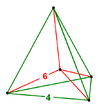Truncated 24-cell honeycomb
In four-dimensional Euclidean geometry, the truncated 24-cell honeycomb is a uniform space-filling honeycomb. It can be seen as a truncation of the regular 24-cell honeycomb, containing tesseract and truncated 24-cell cells.
| Truncated 24-cell honeycomb | |
|---|---|
| (No image) | |
| Type | Uniform 4-honeycomb |
| Schläfli symbol | t{3,4,3,3} tr{3,3,4,3} t2r{4,3,3,4} t2r{4,3,31,1} t{31,1,1,1} |
| Coxeter-Dynkin diagrams |
|
| 4-face type | Tesseract Truncated 24-cell |
| Cell type | Cube Truncated octahedron |
| Face type | Square Triangle |
| Vertex figure |  Tetrahedral pyramid |
| Coxeter groups | , [3,4,3,3] , [4,3,31,1] , [4,3,3,4] , [31,1,1,1] |
| Properties | Vertex transitive |
It has a uniform alternation, called the snub 24-cell honeycomb. It is a snub from the construction. This truncated 24-cell has Schläfli symbol t{31,1,1,1}, and its snub is represented as s{31,1,1,1}.
Alternate names
- Truncated icositetrachoric tetracomb
- Truncated icositetrachoric honeycomb
- Cantitruncated 16-cell honeycomb
- Bicantitruncated tesseractic honeycomb
Symmetry constructions
There are five different symmetry constructions of this tessellation. Each symmetry can be represented by different arrangements of colored truncated 24-cell facets. In all cases, four truncated 24-cells, and one tesseract meet at each vertex, but the vertex figures have different symmetry generators.
| Coxeter group | Coxeter diagram |
Facets | Vertex figure | Vertex figure symmetry (order) |
|---|---|---|---|---|
= [3,4,3,3] |
4: 1: |
 |
(24) | |
= [3,3,4,3] |
3: 1: 1: |
 |
(6) | |
= [4,3,3,4] |
2,2: 1: |
 |
(4) | |
= [31,1,3,4] |
1,1: 2: 1: |
 |
(2) | |
= [31,1,1,1] |
1,1,1,1: 1: |
 |
[ ]+ (1) |
See also
Regular and uniform honeycombs in 4-space:
- Tesseractic honeycomb
- 16-cell honeycomb
- 24-cell honeycomb
- Rectified 24-cell honeycomb
- Snub 24-cell honeycomb
- 5-cell honeycomb
- Truncated 5-cell honeycomb
- Omnitruncated 5-cell honeycomb
References
- Coxeter, H.S.M. Regular Polytopes, (3rd edition, 1973), Dover edition, ISBN 0-486-61480-8 p. 296, Table II: Regular honeycombs
- Kaleidoscopes: Selected Writings of H. S. M. Coxeter, edited by F. Arthur Sherk, Peter McMullen, Anthony C. Thompson, Asia Ivic Weiss, Wiley-Interscience Publication, 1995, ISBN 978-0-471-01003-6
- (Paper 24) H.S.M. Coxeter, Regular and Semi-Regular Polytopes III, [Math. Zeit. 200 (1988) 3-45]
- George Olshevsky, Uniform Panoploid Tetracombs, Manuscript (2006) (Complete list of 11 convex uniform tilings, 28 convex uniform honeycombs, and 143 convex uniform tetracombs) Model 99
- Klitzing, Richard. "4D Euclidean tesselations". o4x3x3x4o, x3x3x *b3x4o, x3x3x *b3x *b3x, o3o3o4x3x, x3x3x4o3o - ticot - O99
Fundamental convex regular and uniform honeycombs in dimensions 2-9 | ||||||
|---|---|---|---|---|---|---|
| Space | Family | / / | ||||
| E2 | Uniform tiling | {3[3]} | δ3 | hδ3 | qδ3 | Hexagonal |
| E3 | Uniform convex honeycomb | {3[4]} | δ4 | hδ4 | qδ4 | |
| E4 | Uniform 4-honeycomb | {3[5]} | δ5 | hδ5 | qδ5 | 24-cell honeycomb |
| E5 | Uniform 5-honeycomb | {3[6]} | δ6 | hδ6 | qδ6 | |
| E6 | Uniform 6-honeycomb | {3[7]} | δ7 | hδ7 | qδ7 | 222 |
| E7 | Uniform 7-honeycomb | {3[8]} | δ8 | hδ8 | qδ8 | 133 • 331 |
| E8 | Uniform 8-honeycomb | {3[9]} | δ9 | hδ9 | qδ9 | 152 • 251 • 521 |
| E9 | Uniform 9-honeycomb | {3[10]} | δ10 | hδ10 | qδ10 | |
| En-1 | Uniform (n-1)-honeycomb | {3[n]} | δn | hδn | qδn | 1k2 • 2k1 • k21 |